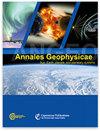The Origins of a Near-Ecliptic Merged Interaction Region as a Magnetic-Cloud like Structure Embedded in a Co-rotating Interaction Region
IF 1.9
4区 地球科学
Q3 ASTRONOMY & ASTROPHYSICS
引用次数: 0
Abstract
Abstract. Using remote-sensing and in-situ observations across multiple spacecraft with complimentary methods of analysis, we investigate a Magnetic Cloud Like-structure (MCL) observed in-situ on 3–4 July 2007 near the ecliptic at OMNI, STEREO-A and -B (all within 15° longitude of Earth). The MCL is entrained in a Corotating Interaction Region (CIR) originating in the Northern heliospheric sector, to create a Merged Interaction Region (MIR). This event allows the comparison of MIR observations at different longitudes showing differences in size, formation of sheath, presence of forward and reverse waves and small-scale structuring, demonstrating the progression of the interaction between the CIR and MCL from West to East. In order to explore its origins further, we compare the MIR with the (Interplanetary) Coronal Mass Ejection (ICME/CME) studied in Maunder et al. (2022) in the mid-latitudes at Ulysses containing a Magnetic Cloud (MC) and present a comprehensive discussion of the challenges posed by observing and relating transients not in alignment, across different latitudes and longitudes, and in different solar wind environments. As the CME propagates almost directly towards Ulysses, we find through fitting and modelling that its flanks could also potentially skim the near-ecliptic spacecraft. Length-scale analysis appears to be consistent with this configuration. However, local expansion velocities of the MCL/MC indicate compression near the ecliptic and expansion at Ulysses and the magnetic flux rope orientations and helicities at the different latitudes oppose each other. The CIR likely causes more compression and re-aligns the transient axis orientation near the ecliptic while a High Speed Stream (HSS) from the Southern sector propagates directly into the back of the ICME/MC near the mid-latitude. Opposing signs of helicity could provide indications of flux added in the first stages of CME evolution or magnetic reconnection with the Heliospheric Current Sheet (HCS). These observations and analyses demonstrate the continued challenge of modelling and fitting the propagation of transients embedded in complex solar wind environments. We note some of the caveats and limitations in the methods and highlight the use of multi-spacecraft analysis to disentangle the origin and formation of ICME substructures from the solar wind and other transients.近黄道合并相互作用区的起源--嵌入同向旋转相互作用区的磁云状结构
摘要。我们利用多个航天器的遥感和原位观测以及辅助分析方法,研究了 2007 年 7 月 3-4 日在 OMNI、STEREO-A 和 -B(均在地球经度 15°范围内)黄道附近原位观测到的磁云样结构(MCL)。MCL 被一个源自日光层北部扇区的 Corotating Interaction Region (CIR) 所夹带,形成一个合并 Interaction Region (MIR)。通过这一事件,可以对不同经度的 MIR 观测结果进行比较,结果表明,MIR 的大小、鞘的形成、正向和反向波的存在以及小尺度结构都存在差异,显示出 CIR 和 MCL 之间的相互作用是自西向东发展的。为了进一步探究其起源,我们将 MIR 与 Maunder 等人(2022 年)在中纬度包含磁云(MC)的尤利西斯研究的(行星际)日冕物质抛射(ICME/CME)进行了比较,并全面讨论了在不同纬度和经度以及不同太阳风环境下观测瞬变并将其与不一致的瞬变联系起来所带来的挑战。当 CME 几乎直接向尤利西斯传播时,我们通过拟合和建模发现,它的侧面也有可能掠过近地轨道航天器。长度尺度分析似乎与这种构造一致。然而,MCL/MC 的局部膨胀速度表明,黄道附近存在压缩,而尤利西斯则存在膨胀,不同纬度的磁通绳方向和螺旋度相互对立。CIR可能会在黄道附近造成更大的压缩并重新调整瞬变轴的方向,而来自南扇区的高速流(HSS)则在中纬度附近直接传播到ICME/MC的背面。相反的螺旋迹象可能表明在 CME 演化的第一阶段增加了磁通量,或者与日光层电流片(HCS)发生了磁重联。这些观测和分析表明,对嵌入复杂太阳风环境中的瞬态传播进行建模和拟合仍是一项挑战。我们注意到这些方法中的一些注意事项和局限性,并强调使用多航天器分析来从太阳风和其他瞬变现象中析出集成流体动力学子结构的起源和形成。
本文章由计算机程序翻译,如有差异,请以英文原文为准。
求助全文
约1分钟内获得全文
求助全文
来源期刊

Annales Geophysicae
地学-地球科学综合
CiteScore
4.30
自引率
0.00%
发文量
42
审稿时长
2 months
期刊介绍:
Annales Geophysicae (ANGEO) is a not-for-profit international multi- and inter-disciplinary scientific open-access journal in the field of solar–terrestrial and planetary sciences. ANGEO publishes original articles and short communications (letters) on research of the Sun–Earth system, including the science of space weather, solar–terrestrial plasma physics, the Earth''s ionosphere and atmosphere, the magnetosphere, and the study of planets and planetary systems, the interaction between the different spheres of a planet, and the interaction across the planetary system. Topics range from space weathering, planetary magnetic field, and planetary interior and surface dynamics to the formation and evolution of planetary systems.
 求助内容:
求助内容: 应助结果提醒方式:
应助结果提醒方式:


